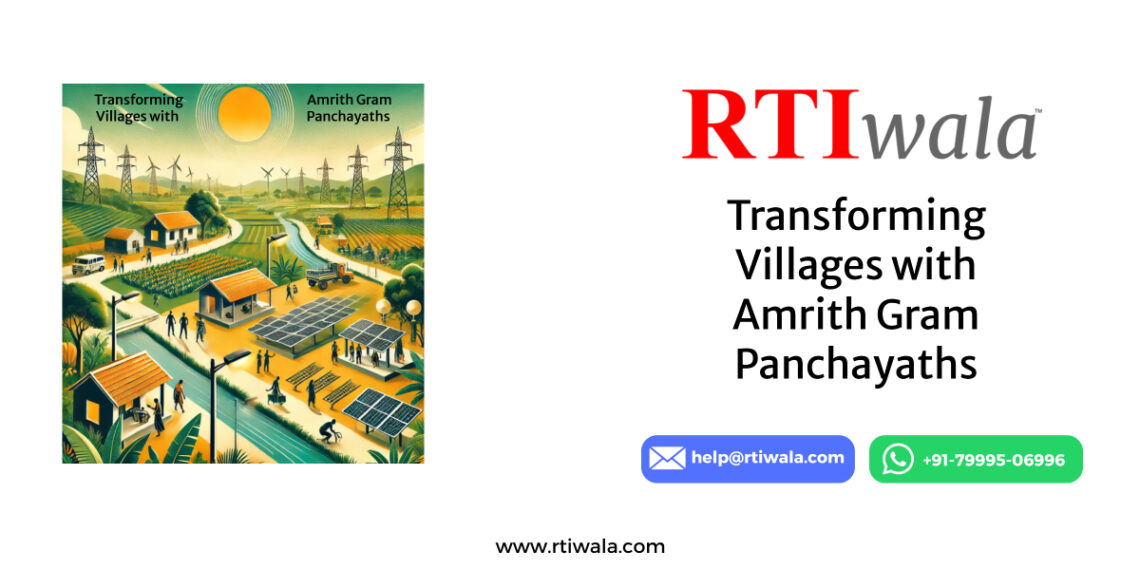Introduction
Rural development is key to a nation’s progress, and strong local governance plays a pivotal role in driving this transformation. To strengthen rural infrastructure, promote sustainability, and enhance governance, the Government of India launched the Amrith Gram Panchayaths initiative. This ambitious program focuses on transforming villages into models of holistic development, emphasizing community participation, sustainability, and quality infrastructure.
In this article, we explore the objectives, features, and impact of the Amrith Gram Panchayaths initiative, highlighting its role in empowering rural communities.
What is the Amrith Gram Panchayaths Initiative?
The Amrith Gram Panchayaths initiative is a rural development program launched under the Amrit Mahotsav of Azadi celebrations, commemorating 75 years of India’s independence. The scheme aims to transform selected Gram Panchayaths into sustainable, inclusive, and model rural communities by focusing on governance, infrastructure, education, health, and livelihood generation.
Key Features:
- Holistic Rural Development: Focuses on health, education, livelihoods, infrastructure, and governance.
- Sustainability Focus: Promotes eco-friendly practices such as renewable energy, water conservation, and waste management.
- Community-Driven Approach: Encourages active participation of local residents in decision-making and project implementation.
Objectives of Amrith Gram Panchayaths
- Strengthen Local Governance: Empower Gram Panchayaths with resources and decision-making authority.
- Promote Inclusive Development: Ensure equitable access to resources and services for all, especially marginalized communities.
- Enhance Quality of Life: Provide rural residents with better infrastructure, healthcare, and education.
- Foster Sustainability: Encourage practices that conserve natural resources and promote eco-friendly development.
- Boost Livelihood Opportunities: Support skill development and entrepreneurship in rural areas.
Key Components of the Initiative
- Infrastructure Development:
- Build or upgrade essential infrastructure, including roads, schools, healthcare centers, and public utilities.
- Sustainability Initiatives:
- Implement renewable energy projects like solar lighting.
- Promote rainwater harvesting and efficient irrigation techniques.
- Digital Empowerment:
- Digitize governance processes to ensure transparency and efficient service delivery.
- Provide digital literacy training to residents.
- Health and Education:
- Establish primary healthcare centers and improve access to quality education.
- Promote awareness campaigns on hygiene, nutrition, and preventive healthcare.
- Community Participation:
- Involve local residents in planning, decision-making, and implementation of development projects.
Implementation Framework
The Amrith Gram Panchayaths initiative follows a decentralized model, empowering local bodies to tailor solutions to the unique needs of their communities.
Implementation Steps:
- Selection of Gram Panchayaths:
- Identify and select Gram Panchayaths based on their development potential and socio-economic indicators.
- Capacity Building:
- Train Panchayath officials and local leaders to effectively manage resources and projects.
- Resource Mobilization:
- Secure funds through central, state, and local government schemes, along with public-private partnerships (PPPs).
- Project Execution:
- Execute projects focusing on key areas like health, education, infrastructure, and sustainability.
- Monitoring and Evaluation:
- Use digital tools and regular audits to track progress and ensure accountability.
Benefits of Amrith Gram Panchayaths
- Improved Quality of Life:
- Provides rural residents with better access to healthcare, education, and basic amenities.
- Economic Upliftment:
- Creates job opportunities and promotes skill development for rural populations.
- Sustainable Development:
- Encourages eco-friendly practices like renewable energy and efficient water management.
- Empowered Governance:
- Strengthens the role of Gram Panchayaths in decision-making and local development.
- Social Inclusion:
- Ensures equitable development, benefiting marginalized and vulnerable groups.
Challenges and Solutions
Challenges:
- Limited financial resources for comprehensive rural development.
- Resistance to change and adoption of modern practices in some communities.
- Ensuring community participation and accountability in large-scale projects.
Solutions:
- Enhance funding through public-private partnerships and donor programs.
- Conduct awareness campaigns to educate communities on the benefits of the initiative.
- Use technology to monitor and evaluate project progress, ensuring transparency.
Filing RTI for Scheme-Related Queries with RTIwala
Citizens and local leaders seeking information about the Amrith Gram Panchayaths initiative can file a Right to Information (RTI) application to access details about project funding, implementation, and outcomes. RTIwala provides expert support for filing RTI effectively.
How RTIwala Can Help:
- Transparency: Access detailed information about project selection, budgets, and execution.
- Issue Resolution: Address delays or discrepancies in project implementation.
- Customized RTI Applications: Draft targeted queries for specific concerns.
Explore RTIwala services:
- Online RTI Filing: Submit RTI conveniently online for rural development-related queries.
- Custom Drafting Services: Professionally crafted RTI applications for rural governance issues.
- Anonymous RTI Filing: Ensure privacy for sensitive inquiries.
Promoting RTIwala Services
For citizens and Panchayaths looking to monitor or benefit from the Amrith Gram Panchayaths initiative, RTIwala ensures transparency and accountability. Use their services to stay informed and resolve challenges:
- Expert Consultation: Personalized advice for scheme-related concerns.
- Anonymous Filing Services: Private and secure RTI submissions.
Conclusion
The Amrith Gram Panchayaths initiative is a transformative step toward empowering rural India and fostering sustainable development. By focusing on governance, infrastructure, and community engagement, the scheme paves the way for a brighter and more inclusive future for villages across the country.If you or your community is part of this initiative, take full advantage of its resources and actively participate in its success. For assistance in accessing or monitoring the scheme, trust RTIwala to provide expert guidance and support.















































